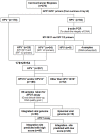HPV genotyping and site of viral integration in cervical cancers in Indian women
- PMID: 22815898
- PMCID: PMC3397968
- DOI: 10.1371/journal.pone.0041012
HPV genotyping and site of viral integration in cervical cancers in Indian women
Abstract
Persistent HPV infection plays a major role in cervical cancer. This study was undertaken to identify HPV types in a cohort of Indian women with locally advanced cervical cancer as well as to determine the physical state and/or site of viral integration in the host genome. Pretreatment biopsies (n = 270) from patients were screened for HPV infection by a high throughput HPV genotyping assay based on luminex xMAP technology as well as MY09/11 PCR and SPF1/2 PCR. Overall HPV positivity was observed to be 95%, with HPV16 being most common (63%) followed by infection with HPV18. Integration status of the virus was identified using Amplification of Papillomavirus Oncogene Transcripts (APOT) assay in a subset of samples positive for HPV16 and/or HPV18 (n = 86) and with an adequate follow-up. The data was correlated with clinical outcome of the patients. Integration of the viral genome was observed in 79% of the cases and a preference for integration into the chromosomal loci 1p, 3q, 6q, 11q, 13q and 20q was seen. Clinical data revealed that the physical state of the virus (integrated or episomal) could be an important prognostic marker for cervical cancer.
Conflict of interest statement
Figures




References
-
- Munoz N, Bosch FX, de Sanjose S, Herrero R, Castellsague X, et al. Epidemiologic classification of human papillomavirus types associated with cervical cancer. N Engl J Med. 2003;348:518–527. - PubMed
-
- Wentzensen N, Vinokurova S, von Knebel Doeberitz M. Systematic review of genomic integration sites of human papillomavirus genomes in epithelial dysplasia and invasive cancer of the female lower genital tract. Cancer Res. 2004;64:3878–3884. - PubMed
Publication types
MeSH terms
LinkOut - more resources
Full Text Sources
Other Literature Sources
Medical

